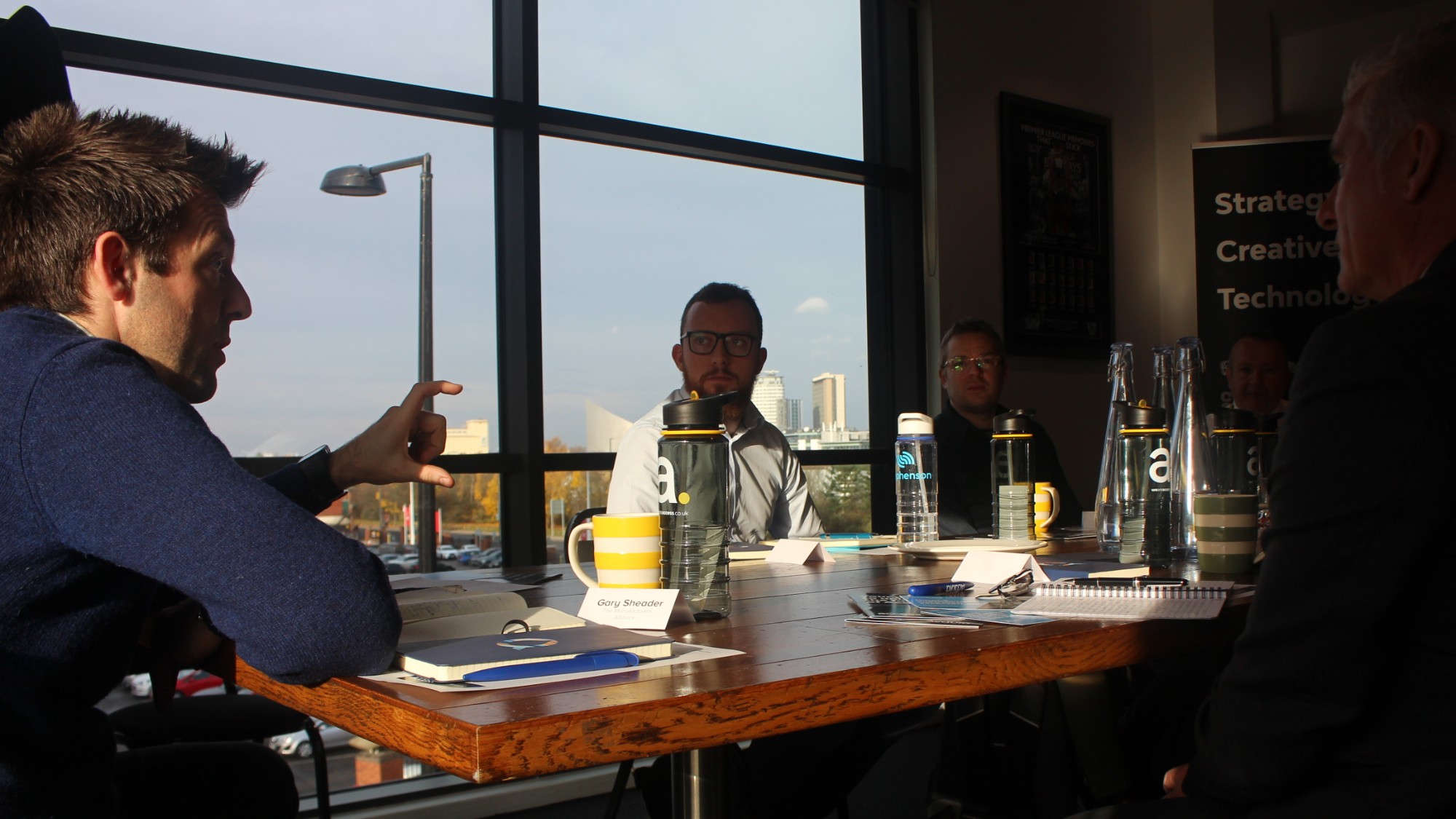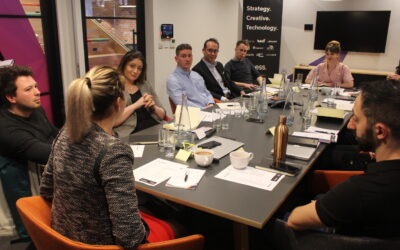Review: Prolific North’s Manufacturers’ Roundtable – Would eCommerce work for you?

-
by Josh Peachey
Subscribe to the Prolific North Daily Newsletter Today!
Want all the latest content from Prolific North delivered direct to your inbox daily? Of course you do!


In the UK, manufacturing accounts for 44% of total UK exports and 70% of business R&D. It employs 2.6 million people and is currently the world’s eighth-largest industrial nation.
However, the nature of trade in this sector is changing and manufacturers are having to become more dynamic, tech-savvy and more facilitating.
We gathered a number of senior figures from the region’s manufacturing companies to come together at Hotel Football, Old Trafford, to discuss some of the challenges they’ve faced, are facing, or have overcome, when it comes to adopting an eCommerce strategy.
Chaired by Gary Sheader, Chairman of the Manufacturers Alliance
Attendees:
- Tom Kirk, Managing Director & Owner of Francis Kirk
- Gavin Hepburn, Managing Director, ATG Access
- Neil Davies, Marketing Director, Sentinel
- Paul Blount, Group Marketing Director, SC Johnson Professional
- James Clews, Sales & Marketing Director, Stephenson Personal Care
- Simon Landi, Managing Director & Owner, Access
- Alan Botwright, Senior Solutions Architect, Acquia

The morning discussion took place at Hotel Football in Old Trafford, Manchester
After some breakfast networking, the discussion began with Gary Sheader (Manufacturers Alliance) welcoming everyone before each guest introduced themselves and talked briefly about what their manufacturing company does.
Paul Blount (SC Johnson) said that, as a manufacturer of predominantly skin care products and cleaning products for workplaces, they have a lot of online presence but don’t do any online trading. “We do a lot of business with SMEs and maybe they’re buying like consumers so potentially there are some opportunities there for us.”
When Tom Kirk (Francis Kirk) came into the family business 15 years ago, they didn’t have a computer system. “After implementing two systems in since, we’re now actually on the journey to becoming a B2B/B2C eCommerce site.” He said that this came from the company’s distribution network, who just wanted to click online to order products in.
Simon Landi (Access) said that he was pleased to be able to sponsor the morning’s roundtable especially after talking to some of his agency’s clients who have been debating getting involved in eCommerce for the last few years.
Neil Davies’ (Sentinel) company has been creating maintenance products in the plumbing and heating sector for over 30 years, across residential, commercial and international. He said that during the 12 years he’s been in the business, they’ve been focusing on getting their website to a good place but “everyone wants something slightly different and as a consequence, we’ve aimed to get our website to be informative, educational and lead-generating.” His main wonder was whether the company should go direct instead of through distributors.
Gavin Hepburn (ATG Access) pointed out the window to the infamous football ground, Old Trafford, explaining that his company had just finished a security installation here. Their products include bollards, gating, and higher-level security infrastructure, primarily protecting airports, government buildings, embassies. “We’re having a new website being built currently but traditionally we suffer from trying to keep too many people happy with the website. We do everything from £200 bollards to $10 million projects for airports and we don’t want to missell or confuse anybody looking for a specific solution.”
Alan Botwright (Acquia) shared a different perspective. Coming from a digital background, he spoke about his experience working on digital solutions to issues faced by a whole range of companies in different sectors. He said: “The thing I hear more and more is experience matters. What’s the appropriate experience that I get?”
James Clews (Stephenson Personal Care) said that his company is a manufacturer of personal care products and bases. His company’s sales are a split of direct-to-businesses and via distributors to business but not B2C. He said that they used to always declined to speak to smaller clients and refer them through to a distributor, but now they have a list price and distributors get a discount off that. “We don’t know whether this leads us into a B2C business but what we do know, is that we want to give customers as little friction with us as possible.”
Gary Sheader (Manufacturers Alliance) talked about the need for the industry to come together to share ideas on all facets of running a business. He said: “We’re lagging behind a lot of manufacturing industries in Europe when it comes to the adoption of technology. We need to be embracing eCommerce and other technology to help us have faster growth and be more efficient, and have shorter lead times.”

Gary Sheader, Chairman of the Manufacturers Alliance, chaired the morning discussion
Tom (Francis Kirk) asked Gary what sort of percentage of manufacturers, from across Europe, see themselves as manufacturers as opposed to manufacturing distributor. Gary responded by saying that he thinks “the companies that are doing well, see themselves as services businesses, that happen to make stuff.”
Tom expressed one challenge that he faced regarding lead timings, talking about how “nowadays, the end-user wants and expects the product tomorrow and the pressure goes up the line.”
James (Stephenson Personal Care) said that his company had gone the full circle of super customer-focused then a bit operation-led then really operationally-led, “and then we thought, oh! Aren’t we meant to be servicing customers? Back onto that again!” He said that they’re now putting what their system does and current lead times aside, and asking themselves what the customers want and then doing it. “We’ve got to adapt to what the customer needs, and make sure we do it, not convince the customer that what we do is what they need.”
Customer vs. lead time
Gary (Manufacturers Alliance) pointed out how as an industry, when companies meet their own determined lead times, they often see that as a success. “In reality, the customer wanted it in one week, and the manufacturer said that it’ll take four. Instead of them saying that they’ve delivered 99% of products within their four-week timing, they’re actually late on what the customer wants.”
Neil (Sentinel) talked about he combined the marketing and the customer service teams together because the focus is now on customer experience and putting the customer at the heart of everything. “We collected data from all the people on our website asking where they can buy our products. Although we weren’t selling it on the site, we were just telling people where to buy it, it made us think whether we should go that next step further.”
He added that whether you like them or not, it’s the Amazon and other online stockists who focus on convenience and they’re serving people a lot quicker.
Distributor relations
Paul (SC Johnson) highlighted that they even had pushback when putting a ‘Where to buy’ section on their website with distributors questioning who will be featured.
James (Stephenson Personal Care) added that they were terrified of running into a similar problem with distributors by not featuring some and featuring others on their site, or sorting alphabetically, as “some argue that they spend a lot with us and should be featured higher up. That made us indecisive about it all.”
Paul (SC Johnson) said: “Like many companies, we’ve got huge global distributors, with locations all over the world, that we use as well as the smaller local distributors who can do a great job in that area. Who do you favour?”
Neil (Sentinel) said that his company had had enquiries from distributors about not featuring on the site and his solution was to set some clear guidelines if they wanted to be listed online. “We can’t forget that these people are selling our products online as well. We say they can be featured providing that they use our latest branding on their site, if they’re selling 15 of our products, they have to feature all 15 products and make sure that they’re using the marketing materials that we’re providing. It’s conditional.”
Paul (SC Johnson) echoed this by saying that ultimately, companies can support distributors who support them, which many at the table agreed was a good method by many around the table.
Simon (Access) shared some statistics that supported what had been said at the table…
When asked what are the best ways a B2B company can make it easy for customers to do business, the top two answers were:
- The ability to help themselves
- Pricing displayed on the websites
1
“The fourth one is one-click re-ordering. They want to start making a relationship directly,” Simon added. “They want you to understand who they are. This whole idea of personalised journeys fits right into this. If you’re selling through distribution, you have no idea who the end customer is.”
Alan (Acquia) explained the intricacies of the customer journey and used BMW as a great example of a company who’s website informs the company all about the customer. He added: “The gap between researching a product and buying a product is closing, and that’s ‘brandCommerce’.”
Simon (Access) said that everyone is concerned about how the move to eCommerce is going to affect their distribution channels. “It’s about managing that process. It’s not about diving into a whole eCommerce solution that is going to cannibalise sales. It’s almost doing some of it alongside them or doing a pilot.”
Selling individual items rather than ‘truckloads’
Paul (SC Johnson) said he believed setting up a website and pricing was the easy part and asked how a manufacturer can suddenly become a logistics expert and all of a sudden, sell smaller quantities of items instead of the norm – a truckload. “How can we become a distributor ourselves and is that a viable thing for us to attempt to do?”
Gavin (ATG Access) said that in the face of the logistics issue Paul raised, his company invested about £80,000 in stock and put that with a fulfilment company. “It just sits there, and the part numbering isn’t all joined up but it gives us an option to outsource.”
Neil (Sentinel) said that he had seen their prices soar when Sentinel was using a fulfilment company because they were handling all the shipping costs. Instead, they currently trialling Parcels2Go, a company that will pick out the products and pack them up when they come in – orders that he admitted were “sporadic”.
Gary (Manufacturers Alliance) described a company that works with the Alliance who started an eCommerce site operating on a login basis for distributors. It completely streamlined the office-admin process, allowing them to “just take the orders and then drop it into a production schedule.”
James (Stephenson Personal Care) spoke about a trial his company had run in California, where they had used a system that gave customers an option to pay 5% more to be able to collect it from the distribution warehouse. “We’re really transparent, we give them two prices, and most of them are doing both and some of them are only doing it from the warehouse. They love the idea of a premium but not buying 20 pallets, just buying one. If that is worth something to them, then charge for it.”
Multiple customer types, multiple brands and websites
When Gary started talking about different customer types, Gavin (ATG Access) said that they had decided to not have multiple websites, despite having different extremes for his security customers. “I’m possibly regretting that. I think having two different websites or brands might be easier and the better way to do it.”
Tom (Francis Kirk) said that a lot of personalisation and the customer journey comes back to how much data you can get out of the customer from the website.
This was echoed by Alan (Acquia), who explained the variety of ways in which companies can add in tools on the website, such as geotargeting, that are relatively simple to add in but then have a dramatic effect on conversions.
James (Stephenson Personal Care) said many companies who want to try out eCommerce worry too much about their brand and argued that the best thing to do was to create a separate brand, a separate identity. “We haven’t got any B2C to spin it out so letting it fail fast or work can sometimes be the answer.”
Others agreed that it would be a good solution for businesses who were concerned about tarnishing a brand or confusing their audience or even their own staff.
Gavin (ATG Access) and James (Stephenson Personal Care) agreed that it’s usually too resistant an environment to trial these side projects internally. Gavin said that staff complain that they’re too busy which is what James called “the ecosystem killing the idea.”
After Paul (SC Johnson) described his conflict and many of the challenges involved in using logistics companies to help distribute products directly from manufacturers, Tom shared his company’s method for solving that issue.
Tom (Francis Kirk) said that they have an agreement with other manufacturers who are doing the products that his company aren’t manufacturing, and when it goes over a certain value, they’ll send the goods directly for Tom’s company but they’ll take a percentage of the fee for doing that. If it’s under a certain value, then it’s Tom’s responsibility as the ‘distributor’ to actually send that product out.
When the conversation moved onto the idea of manufacturers working in the B2C space, a few guests agreed that the manufacturing company is now a shop that services, which is quite a mentality shift. Gavin (ATG Access) pointed out that there’s no point in doing it without the full effort as it almost becomes “a self-fulfilling prophecy”.
After the roundtable discussion ended, guests stayed to further network and discuss solutions and ideas mentioned by one another throughout the morning.
Conclusion
The morning’s discussion proved to be a contemplative conversation full of industry insight into the challenges manufacturers are facing at the moment. Similarly to other roundtables that we’ve hosted, guests spent a morning learning about the practices of other companies. However, more so than any other roundtable, attendees at this event explained to each other how their tried and tested eCommerce models, or experiences trialling an eCommerce function, would work for the other’s company.
There was genuine intent from guests to collaboratively answer each other’s questions and the main focuses included the need to start being more than a manufacturer, how to manage relations with distributors, collecting data and segmenting customer groups. It seemed clear that all the different companies around the table were looking to improve their company’s offering by introducing eCommerce functionality in one way or another.
Simon Landi, Managing Director of Access, planned to gather the insights from the talk and provide attendees with case examples of successful eCommerce strategy implementation. Simon, added: “Quite often, the most relevant and appropriate method might not be the most obvious. One thing is certain, a degree of eCommerce is inevitable so manufacturers need to get on board and create a strategy to meet their business goals… now.”





















